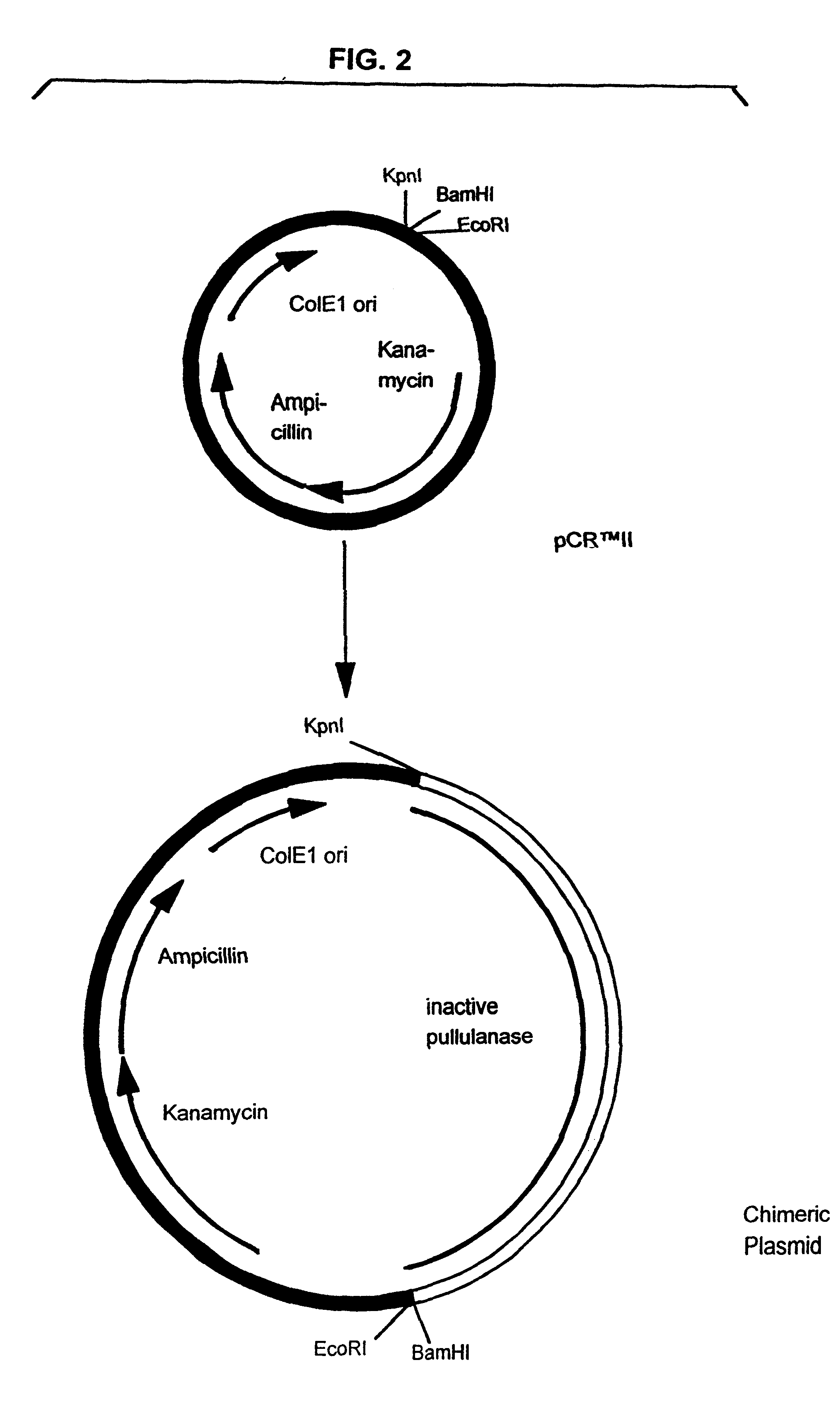Pullulanase expression constructs containing alpha-amylase promoter and leader sequences
- Summary
- Abstract
- Description
- Claims
- Application Information
AI Technical Summary
Benefits of technology
Problems solved by technology
Method used
Image
Examples
example 1
Production of Recombinant Pullulanase
A culture of B. subtilis was transformed via the conventional competent cell method to contain pEB301 and was then cultured under the following conditions:
Cell culture medium
2.0% Difco (Detroit, Mich., USA) tryptone
1.0% Difco yeast extract
2.0% Corn Products International (Summit-Argo, Ill., USA) "GLOBE 1910"-brand maltodextrin
20 .mu.g / ml kanamycin sulfate
The pH of the medium was adjusted to 6.0 and the cell cultures grown in shake flasks at 37.degree. C. with agitation at 200 rpm for 43 hours.
The cell culture medium was assayed for pullulanase activity by the release of reducing sugar from pullulan in the presence of enzyme. A solution (0.5 ml) of 1.0% pullulan (Sigma P4516, Sigma Chemical Co., St. Louis, Mo.) in 50 mM acetic acid-sodium acetate buffer, pH 5.0 was incubated for 10 minutes at 60.degree. C. in 16.times.125 mm culture tubes. An equal volume of sample (which contained from 0.02 to 0.1 U / ml of pullulanase activity)...
example 2
Isolation of Recombinant Pullulanase
Recombinant pullulanase from cell culture media produced as described in Example 1 was isolated as follows:
We adjusted about 250 ml of 700 U / ml pullulanase to 1 M (NH.sub.4).sub.2 SO.sub.4 with 4 M salt and passed it through a laboratory column containing about 100 ml of phenyl sepharose (Phenyl Sepharose 6 Fast Flow; Pharmacia Biotech, Piscataway, N.J.) in 1 M (NH.sub.4).sub.2 SO.sub.4. The material then was washed with 0.6 M (NH.sub.4).sub.2 SO.sub.4 in 50 mM acetate buffer (pH 5.8), and the enzyme eluted with a 400 ml, reverse gradient from 0.6 M to 0.0 M (NH.sub.4).sub.2 SO.sub.4 in 50 mM acetate buffer (pH 5.8). The pullulanase eluted as a broad peak in the final quarter of the gradient. We concentrated the pullulanase to 8 ml by ultrafiltration (YM10 membrane; Amicon, Beverly, Mass.), and further purifed it, in 4-ml aliquots, by size exclusion chromatography (HiPrep 26 / 60 Sephacryl S-100 HR; Pharmacia) in 50 mM acetate buffer (pH 5.8). In th...
example 3
Comparison of Recombinant Pullulanase to Native Pullulanase
We examined the general characteristics of the recombinant pullulanase produced by B. subtilis and compared them to the native pullulanase from B. naganoensis. In each case, the comparisons were performed using the pure native enzyme versus the pure recombinant enzyme. In fact, the pullulanase from either source can be isolated using the methods outlined in Example 2. The similarity of behavior during purification is one indicator that the recombinant protein is identical to the native protein.
Non-denaturing, Polyacrylamide Gel Electrophoresis (PAGE):
Recombinant and native pullulanase were run in parallel lanes in a Novex.TM. precast 10% tris-glycine acrylamide gel (Novel Experimental Technology, Inc., San Diego, Calif.). The results indicate that each enzyme has the same relative mobility. The electrophoresis was performed as described in "Novex.TM. Precast Gel Instructions" and the gel visualized by staining using a slight...
PUM
| Property | Measurement | Unit |
|---|---|---|
| Temperature | aaaaa | aaaaa |
| Volume | aaaaa | aaaaa |
| Volume | aaaaa | aaaaa |
Abstract
Description
Claims
Application Information
 Login to View More
Login to View More - R&D
- Intellectual Property
- Life Sciences
- Materials
- Tech Scout
- Unparalleled Data Quality
- Higher Quality Content
- 60% Fewer Hallucinations
Browse by: Latest US Patents, China's latest patents, Technical Efficacy Thesaurus, Application Domain, Technology Topic, Popular Technical Reports.
© 2025 PatSnap. All rights reserved.Legal|Privacy policy|Modern Slavery Act Transparency Statement|Sitemap|About US| Contact US: help@patsnap.com



